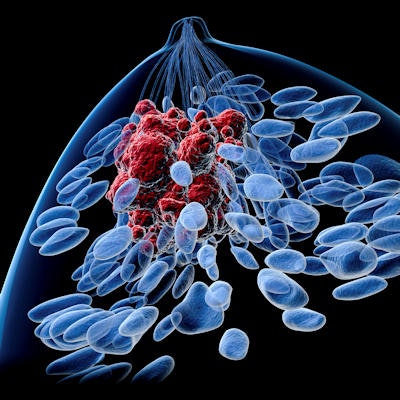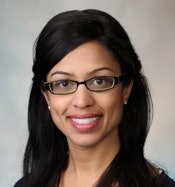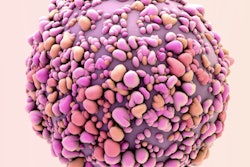
How should women with breast cancer be tracked after lumpectomy or mastectomy? An optimal surveillance regimen has yet to be defined, according to a study published in the January issue of the American Journal of Roentgenology.
 Dr. Bhavika Patel of Mayo Clinic Hospital in Phoenix.
Dr. Bhavika Patel of Mayo Clinic Hospital in Phoenix.
Part of the problem is that there are conflicting studies as to whether surveillance with mammography at six-month intervals is the best course of action after surgery.
"This controversy is reflected in the American College of Radiology Appropriateness Criteria, in which bilateral diagnostic and screening mammography are both deemed appropriate after breast conservation therapy for patients who have undergone lumpectomy 'depending on local protocol,'" the group wrote.
Crucial to clarify
It's important to clarify the surveillance protocol for women with breast cancer who have undergone surgery in order to avoid unnecessary imaging, Patel told AuntMinnie.com. She and her colleagues cited a 2009 survey of physician attitudes -- including primary care physicians and oncologists -- regarding the care of cancer survivors. The survey found that the American Society of Clinical Oncology (ASCO) and the National Comprehensive Cancer Network (NCCN) both recommended unnecessary imaging studies such as chest x-rays and bone scans in this population of women.
"My own experience at various academic centers has shown that each facility has its own protocol -- there's not much consistency," she said. "And this variability can translate into a quality issue, especially if patients don't get predictable, consistent follow-up imaging."
For their study, Patel and colleagues used an online survey to assess radiologists' use of diagnostic versus screening mammography for women with a personal history of breast cancer. The researchers also wanted to investigate whether the choice of either type of exam was associated with practice characteristics such as setting, region, and reader type (general versus dedicated breast radiologists). The survey collected data on the following:
- Demographic characteristics of the facility (setting, location, practice type, and screening and diagnostic mammography volume)
- Number of radiologists
- Number of dedicated breast radiologists
- Standard imaging protocols for patients at higher risk of breast cancer (due to previous lumpectomy or mastectomy, a family history of the disease, or a history of high-risk lesions)
Among the 879 survey respondents, 84% worked in a nonacademic setting, and 60% said they considered their group of radiologists to be dedicated breast imagers. Mean volume per practice was 68 screening and 20 diagnostic mammography exams per day.
Patel and colleagues found that 79% of the radiologists surveyed recommended initial diagnostic mammography after lumpectomy, with 65% recommending this at six months after surgery and 14% at 12 months. After either of these basic protocols, 73% of facilities performed diagnostic mammographic evaluation every six months; the duration of this type of surveillance ranged from one to five years before regular screening mammography resumed. Only a small fraction of respondents (9%) said they recommended permanent use of diagnostic mammography in women with breast cancer who had been treated with surgery.
| Use of mammography surveillance after lumpectomy or mastectomy | |
| Method | Percent use |
| Surveillance protocol after lumpectomy | |
| Diagnostic mammography after 6 months | 65% |
| Diagnostic mammography after 12 months | 14% |
| Screening mammography after 6 months | 13% |
| Screening mammography after 12 months | 8% |
| Surveillance frequency after lumpectomy | |
| Always diagnostic mammography | 9% |
| Diagnostic mammography followed by screening mammography | 73% |
| All screening, no diagnostic mammography | 18% |
| Surveillance protocol after mastectomy (in the unaffected breast) | |
| Always diagnostic mammography | 20% |
| Always screening mammography | 43% |
| Initial diagnostic mammography, then screening | 37% |
Survey respondents who read breast images less than 50% of the time were less likely to recommend diagnostic mammography after lumpectomy than their counterparts, but there was no statistically significant difference by practice setting (academic, community, or private office).
"Our study showed substantial variability among U.S. radiology practices regarding the onset, frequency, and duration of mammographic surveillance after breast-conserving therapy or mastectomy," Patel and colleagues wrote.
Consistency is key
So why might variability among breast cancer postsurgery protocols be a concern? From a patient's point of view, screening versus diagnostic follow-up can have financial and personal consequences, according to Patel. Insurers may charge for diagnostic mammography, while screening may be covered.
But on the other hand, diagnostic mammography has benefits for a breast cancer survivor who may bring extra anxiety into follow-up imaging, such as the exams being read in real-time.
"The beauty of a diagnostic exam is that it's read right then, and the patient gets results without having to wait -- which can be reassuring to a patient who has already had breast cancer," Patel said.
Acknowledging the inconsistency of postsurgery follow-up protocols creates an opportunity for team building across specialties, Patel concluded.
"We hope our study findings shed light on this issue and encourage everyone -- from radiologists to oncologists to surgeons to referring physicians -- to open lines of communication and become acquainted with practice guidelines," she said. "Consistent recommendations from involved caregivers will ensure quality and optimal patient care."




















